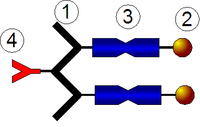
Photo from wikipedia
Proteins are an impactful class of therapeutics but can exhibit suboptimal therapeutic performance, arising from poor control over the timescale of clearance. Covalent PEGylation is one established strategy to extend… Click to show full abstract
Proteins are an impactful class of therapeutics but can exhibit suboptimal therapeutic performance, arising from poor control over the timescale of clearance. Covalent PEGylation is one established strategy to extend circulation time but often at the cost of reduced activity and increased immunogenicity. Supramolecular PEGylation may afford similar benefits without necessitating that the protein be permanently modified with a polymer. Here, we show that insulin pharmacokinetics can be modulated by tuning the affinity-directed dynamics of a host-guest motif used to non-covalently endow insulin with a poly(ethylene glycol) (PEG) chain. When administered subcutaneously, supramolecular PEGylation with higher binding affinities extends the time of total insulin exposure systemically. Pharmacokinetic modeling reveals that the extension in the duration of exposure arises specifically from decreased absorption from the subcutaneous depot governed directly by the affinity and dynamics of host-guest exchange. The lifetime of the supramolecular interaction thus dictates the rate of absorption, with negligible impact attributed to association of the PEG upon rapid dilution of the supramolecular complex in circulation. This modular approach to supramolecular PEGylation offers a powerful tool to tune protein pharmacokinetics in response to the needs of different disease applications.
Journal Title: Biomacromolecules
Year Published: 2021
Link to full text (if available)
Share on Social Media: Sign Up to like & get
recommendations!